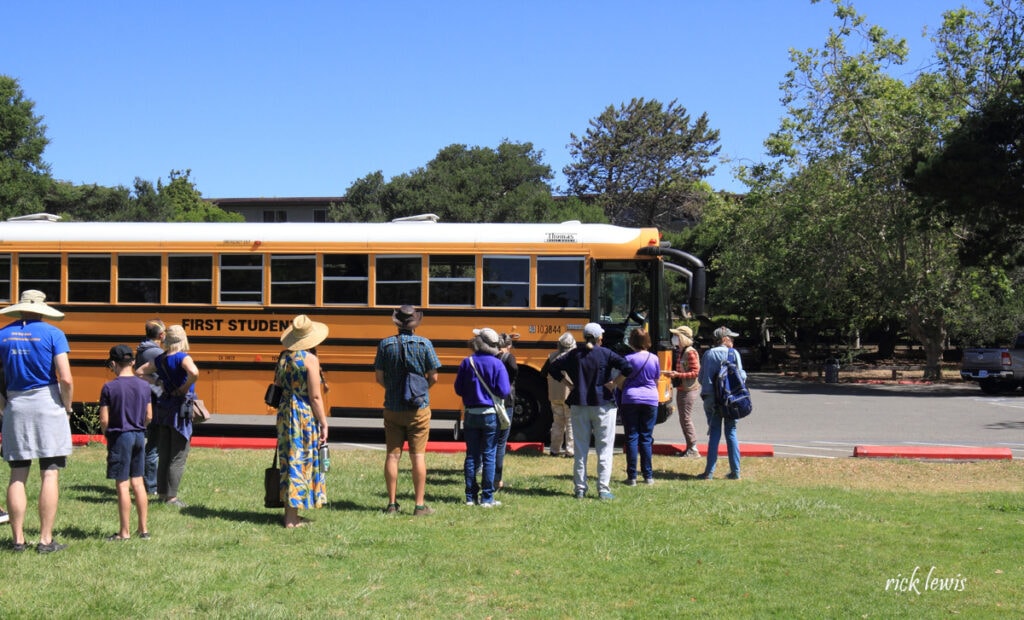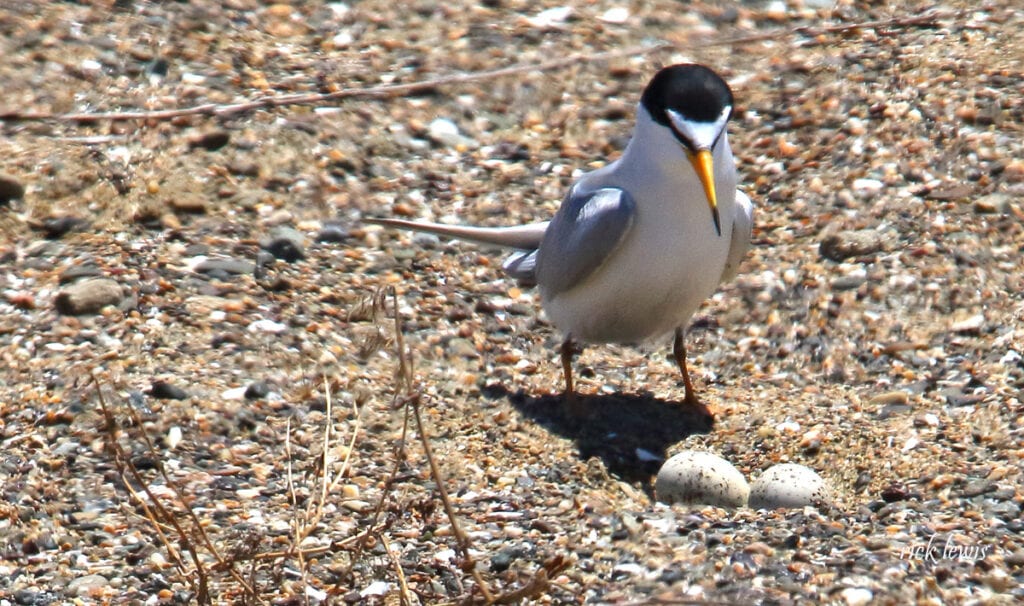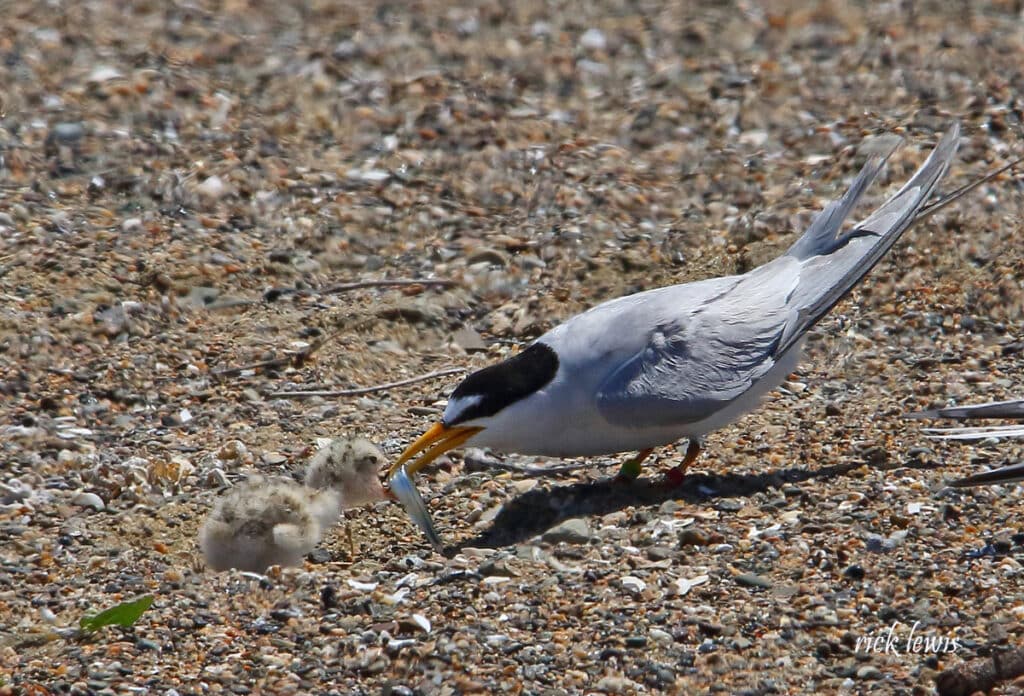How to See Nesting California Least Terns and their Chicks
By Marjorie Powell
California Least Terns (Sternula antillarum browni) can be seen plunge-diving for fish at several East Bay locations in the summer but seeing them nesting is more difficult. Traditionally, Least Terns make scrapes in the sand to lay their two or three eggs, but with beaches full of people and dogs, the terns have found other nest sites. At the Alameda Wildlife Reserve and Hayward Regional Shoreline, large fenced areas protect nesting terns in the Bay Area from mammal predators (feral cats, racoons, etc.) and human disturbance. Devoted birders can serve as monitors for the nesting colonies, alerting US Fish and Wildlife Service (USFWS) when an aerial predator appears (Peregrine Falcons are especially skilled at taking eggs, chicks and sometimes adults), but training for new monitors at the Alameda Reserve has not happened since the start of COVID, and monitoring provides no option for other birders or potential birders.

About the only other option to see eggs and chicks is Return of the Terns. A cooperative endeavor between USFWS, which manages the colony at the Alameda Wildlife Reserve for the Department of Veterans Affair, which now holds title to the land, and Crab Cove, part of the East Bay Regional Park District, Return of the Terns is a yearly event where members of the public can learn about the endangered species. Pre-registered participants spend around 30 minutes on a school bus inside the reserve’s outer fence looking over the breeding site fence to watch chicks running and adults holding small fish while searching for their chick. An unadvertised bonus is the view of San Francisco from the northwestern corner of Alameda.

This year’s presentation was outdoors, with pictures projected onto a canopied screen. Susan Euing, the USFWS Wildlife Biologist who manages the colony, gave the first presentation about Least Terns’ life cycles and nesting practices and then lead three bus tours of twenty-five people to the colony. A Crab Cove naturalist gave the latter two presentations while tours were happening. One important take-away from the presentations is that nesting success depends on the presence of small fish and the absence, or at least lesser presence, of a Peregrine Falcon (they also nest in Alameda).

Inside the reserve, as the bus pulled along one side of the internal fence, everyone stood to look for adults and chicks. Euing points out the A-frames under which chicks can hide from predators or the sun, oyster shells that provide shade and camouflage from aerial predators, and nest markers placed near eggs. She and another USFWS staffer at the back of the bus point out chicks running or sitting under A-frames, adults delivering fish, sitting on eggs or sheltering chicks under their wings. Photographers focus and click, move for a better angle, click. The chicks’ sand-colored camouflage makes them hard to see until they move, although you can find them standing still once you master their shape. The colony fence has a solid layer at the bottom to stop chicks, mobile shortly after hatching, from running through the fence holes onto the tarmac, where they may be more vulnerable to predation. The bus moves to other places along two sides of the colony as Euing searches for spots with more terns before turning 180 degrees so passengers on the other side have a more direct view.
Euing describes how twice weekly she and an aide carefully zigzag throughout the colony to tally adults, nests (placing a numbered marker nearby), eggs, and chicks. To avoid double-counting chicks they mark each counted chick’s head with a green, non-harmful non-permanent marker. The survey just before tour day found over 400 nests with about 360 chicks, and totals have gone up since then.

Terns swallow fish whole, so the chicks need tiny fish; breeding success depends partially on the availability of small fish, shrimp and crustaceans. Everyone looks for adults with fish calling as they fly over the colony searching for their chick. Seeing fluffball chicks taking fish from adults, Janet Carpinelli, Volunteer Services Manager for Golden Gate Bird Alliance, said, “I can’t believe those tiny chicks can eat the seemingly large fish!”
Chicks fledge about three weeks after hatching. Many fledglings hang out on runways outside the colony fence, learning to fish in nearby waters. By late summer adults and juvenile birds will leave the Bay for southern locations; some stop in Mexico while others go as far as Central and northern South America.
The California Least Terns started nesting between the active runways at the Alameda Naval Air Station when the base was closed in 1997. The Friends of the Alameda Wildlife Reserve, Golden Gate Bird Alliance’s conservation committee in Alameda, was instrumental in getting the area protected as a wildlife reserve. The reserve now also hosts colonies of nesting Elegant and Caspian Terns in the northwest corner; all three species can be seen fishing or sitting on the mudflats at Middle Harbor. A portion of the land, including the land where the terns were nesting, was transferred to the Department of Veterans Affairs, which contracts with USFWS to manage the tern colony and allows the Return of the Tern visits to happen.”
Another GGBA member, Beata Milhano, expressed her pleasure much more elegantly than I can.
I have been living in the Bay Area for almost 30 years and had no idea that we had an endangered bird species nesting right in our backyard. So, when I heard about the Return of the Terns trip, I signed up right away for this unique opportunity. As the bus pulled up at the fence surrounding the nesting colony, it felt like we were getting a glimpse into a world of something truly special – precious and fragile. It was a remarkable opportunity to learn, observe, admire and be moved by the elegance of these tiny birds and their resilience to persevere despite tough odds.
